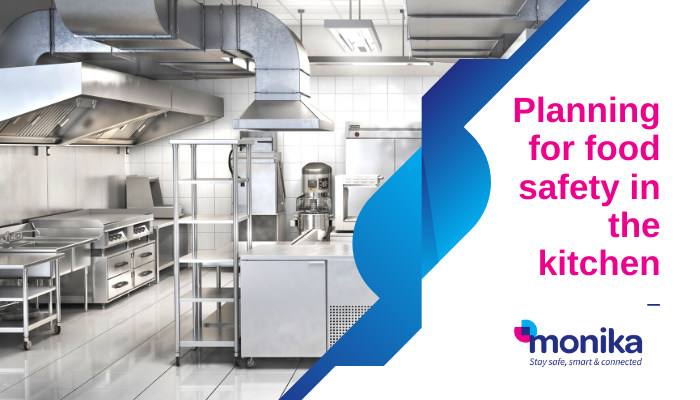
Kitchen design is becoming increasingly focused on food safety and hygiene – while efficiency and productivity continue to be critical to a successful food service operation. So, what’s one thing you can do when planning a new kitchen build or retrofit that ticks both boxes? Include a digital food safety system in your project specifications.
Planning for food safety in a new kitchen project isn’t just the right thing to do – it’s also the smart thing to do. Correct spatial/workflow plans, storage, equipment, fixtures/fittings, ventilation, drainage, and waste will ensure the kitchen can be run both safely and efficiently. But even the best-designed kitchen in the world won’t ensure that a food safety program is implemented correctly.
That’s where a digital food safety system comes in. Digitising food safety processes – from temperature control to hygiene tasks and quality checks – is one of the smartest investments you can make to your foodservice operation. It streamlines and automates many tasks and, over time, pays dividends in reduced labour costs, stock losses and equipment running costs.
Many digital systems address just one aspect of food safety – usually temperature control. But it pays to invest in a system that covers the full spectrum of food safety and hygiene tasks – including cleaning, pest control and maintenance.
A digital food safety system should:
A digital food safety system is never ‘one size fits all.’ It needs to be a flexible solution that can be adapted to each business's unique regulatory and operational requirements for safety, quality, and hygiene.
MonikaPrime can be used for accreditation and implementation of safety and quality plans such as a HACCP food safety management plan and International Standards such as ISO/IEC 17025, 15189, 7218 and 22000. It can also cover aspects of COVID-safe compliance, such as checks to hand sanitiser stations, surface cleaning and sanitisation.
The two fundamental pillars of HACCP are temperature control (to kill bacteria or prevent its growth) and hygiene practices (to detect or prevent contamination).
A best practice digital food safety system will encompass both. Most systems just focus on recording temperatures – and neglect critical routine tasks such as cleaning, equipment maintenance, shelf-life checks, open and closing checks, stock rotation and general hygiene.
Staff should be equipped with dedicated, handheld touchscreen devices to record their food safety data. Smartphones and tablets loaded with a food safety app are not best practices – they are unhygienic and don’t belong in food preparation areas.
A key feature that distinguishes different digital food safety systems is the type of temperature sensors used – the key ones being core product (food simulation) sensors and air sensors.
Air doesn’t behave like food, so it is not an accurate safety assessment. Core product sensors simulate the way that food responds to temperature fluctuations, providing real reassurance that food is being kept safely.
While core product sensors can accurately tell you when your food must be moved, used immediately or thrown away, air temperature is an early indicator of an equipment problem that could lead to stock loss.
✘ Not an accurate food safety assessment, particularly if the unit is incorrectly loaded
✘ Susceptible to dramatic fluctuations in temperature
✘ Can result in nuisance alarms e.g. from doors being left open temporarily
✓An early indicator of an equipment problem – helping you save your stock before it fails
✓ Accurate food safety assessment – including when the fridge is overloaded
✓ Can mimic specific types of food in storage e.g., chicken
✓ Triggers alarm only when there is a genuine food safety risk
Getting remote access to data in real-time can be difficult in commercial kitchen environments: wireless signals can be blocked by stainless steel or interrupted by liquids that can absorb the wavelengths of Wi-Fi.
It’s important to find a digital food safety system that uses robust wireless technology that has been built, tried, and tested for harsh environments. It needs to work around black spots created by stainless steel and other barriers.
The network should operate independently of each site’s IT infrastructure. This is to prevent possible security breaches and allow remote access by your digital food safety system supplier for support and upgrades without the hindrance of IT firewalls.
A digital food safety system can provide the data insights that managers and safety/compliance staff need to keep on top of food safety. It should provide clear, customisable reports on-demand, saving staff time collating and interpreting data.
All food safety activity – from live temperature monitoring to food safety and hygiene tasks – should be fully traceable to date, time, user and location for full management oversight, auditing, compliance, and accreditation purposes.
To find out more about specifying MonikaPrime in your next kitchen project, please contact us for a free demonstration, where we will show you exactly how it can work for you.
Monika has provided food safety and hygiene solutions to healthcare and foodservice institutions worldwide since the early 1990s. Our product simulation technology originated from research conducted in an accredited laboratory into 100+ different product types.
Please note: This blog was first published on Monika blog in March 2021
_1.png)